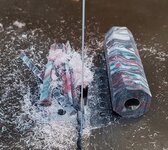Chad,
I got shown up big time when I lived in Japan (26 years). A Japanese man heard me using the router in my garage (with the door down) and knocked on it. He introduced himself and said he heard my router and knew what I was doing (routing). Although fluent in Japanese, occasionally I ran into a Japanese who was just difficult to understand even if I understood the words. He was on of those. We talked shop, but I didn't fully understand what he did; I showed him some of my tools and some of my work. I asked him what he did and he replied he made woodworking tools. (He was speaking of his hobby at the time, not about his work, but I didn't know that at that time.) He lived about 1/2 mile away and one day he invited me to his home. I went and was absolutely floored. Most beautiful and artistic woodworking inside that I had ever seen. I asked his wife what kind of work he did and she replied: He is an art professor at a University in Osaka.
He took me into his basement and I saw 2 meter long ribbons of wood he had hand planed. They were so thin that I could read a newspaper through it. I was floored and commented how great his skill was, and how sharp his tools were. He said: They aren't sharp enough. I will call you to come over after I have sharpened my hand planes and let you see what a "sharp" plane will do.
About two week later he invited me over. I went, and he began to explain: "You know that humidity changes causes dimensional changes in wood from day to day?" Me: "Yes, very familiar with that."
Him: Well two days ago I planed this board he pointed to - 2 x 8 some kind of fir, about 1 meter long. (then he went into details that were difficult to understand but he got his point across). - with humidity changes, the soft wood between the hard grains swell by a hundredth of a mm more than the hard wood. Do you understand that?"
Me, Yes.
Him, "well I can plane those raised sections off and it will look like strings, when my plane is sharp."
He DID. strings, not ribbons. And that was with Japanese planes that he set by tapping the front and sides with a small hammer to set.
(He became friends wth Sam Maloof in Sam's last few years. )
As to needing to rough wood for finish to stick to: I suppose there may be some paints that won't stick to some woods, but I have had difficulty in thinking along those lines. House paint will stick to a window pane for 40 years, through heat and freezing temps; CA will keep a rear view mirror attached to a windshield for 40 years. Oily wood, woods that expand and contract a lot will cause the paint to loose adhesion, but that is not because of the paint or smoothness, but more or less from the wood expanding and contracting.
I would love to see some of your work, when you have time to post some.

